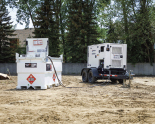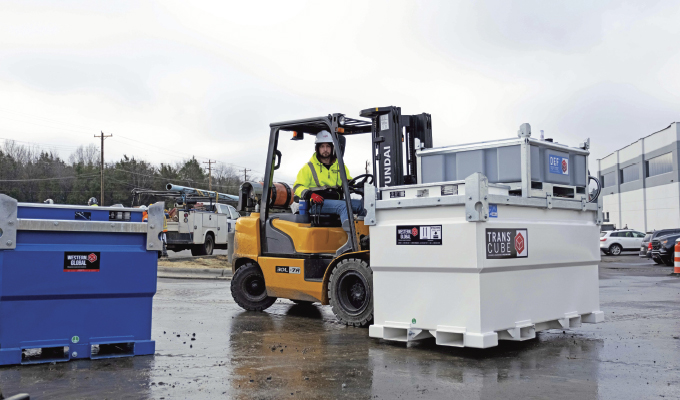Ensuring generator fuel levels are in check can be a challenge when they are constantly running. Most generators contain internal tanks with enough fuel to power the machine for 24 hours, so someone must be tasked with regularly monitoring the fuel level and then refilling the tank at least daily. Though it may not sound like a lot, this can add up to considerable lost time and revenue over the duration of a job. Falling behind on fuel monitoring can lead to surprise downtime for refueling or worse—the unit running entirely dry.
Opting for an external fuel tank with a direct connection to the generator provides for a simple, time-saving solution to keep generators going. An auxiliary fuel tank can extend a generator’s runtime from 24 hours up to a week, leading to considerable time and cost savings. It’s important, however, to consider several crucial factors to get the most out of an auxiliary fuel tank.
CHOOSING THE TANK SIZE
Auxiliary fuel tanks range in capacity from less than 150 gallons to ISO-container-sized tanks that hold upward of 25,000 gallons. To determine the capacity best suited to a jobsite, account for the equipment the tank will fuel and determine how often a fuel truck will stop by. For example, a 100-kilowatt generator burns about six gph at a three-quarter load, or 144 gallons per day. If a tank will fuel a couple of these generators around the clock, a 2,100-gallon tank allows for about 7 days between fuel deliveries.
Some on-site fuel tanks can supply up to three pieces of equipment at the same time, providing the ability to refuel haul trucks, excavators and other jobsite equipment while extending the generator’s runtime. It’s important to include fuel needs for this additional equipment when calculating the tank’s capacity.
Even in situations where the auxiliary tank is not much larger than the generator’s onboard tank, connecting the generator to the auxiliary supply means there is always an emergency reserve of fuel. If something were to interrupt the fuel supply—a late delivery or the equipment being overlooked during a fuel drop—the contractor can simply flip the three-way fuel valve on the generator and switch over to the other fuel tank, providing 12 to 24 hours of additional runtime. Without this redundancy, a generator is always in a situation where it is merely hours from running out of fuel.

TRANSPORTABILITY NEEDS
Contractors should determine whether the generator is stationary or if it will move around the jobsite. Look for fuel tanks that offer more options for maneuverability, such as forklift pockets, to ensure the tank can quickly and easily be relocated along with the generator. Some transportable fuel tanks even offer the ability to be mounted to a trailer or hauled in the back of a truck for easy transportability around the jobsite or over the highway for on-the-go fuel delivery where needed.
Transportable fuel tanks can also improve fuel efficiency on jobsites since they don’t need to be drained and restocked with fuel with each move. Additionally, tanks with double-walled containment eliminate the setup time required with a secondary containment pan. So as generators move around the work zone, the transportable fuel tanks can follow each step of the way without the time and expense required to move a traditional fuel tank.
ENVIRONMENTAL STANDARDS
It’s a given that fuel tanks need to meet environmental standards, but some do so in ways that expend less time and money. Choosing a tank with built-in 110% containment eliminates the need for secondary containment pans, which not only require a time-consuming setup process but are also a nuisance and an additional expense to clean. Double-walled units with removable inner tanks further reduce cleaning time by making it easy for workers to thoroughly clean a tank following a contained spill.
Additionally, contractors should consider adding an on-site diesel exhaust fluid (DEF) storage tank to simplify compliance with Tier 4 Final engine requirements. Some manufacturers offer DEF solutions that provide bulk storage—either as a standalone tank or mounted to the top of a fuel tank—to conveniently store DEF in quantities that will maintain the proportional relationship of about 10% of DEF per gallon of diesel. For stationary equipment like generators, some of today’s solutions feature an innovative system that monitors the level of DEF in the equipment and automatically replenishes the fluid as needed. These systems bring the same benefits of an auxiliary fuel supply so neither fluid needs frequent monitoring and refilling.
MITIGATING THEFT
Fuel is a significant expense, so preventing theft is a critical factor for an on-site fuel supply. Next-generation transportable fuel tanks keep ports and pumps inside a secure cabinet. These cabinets contain card-lock dispense controls that only allow authorized individuals to access the fuel for an additional level of security.
For added peace of mind, consider a fuel tank that is equipped with a remote monitoring system to track the fuel supply and receive alerts. This helps managers track fuel levels without constantly traveling to the generator, and to become aware of any sudden changes or drops in the fuel supply.
CLOSING THOUGHT
Adding on-site fuel storage to a jobsite provides benefits across the board. The same solutions that extend generator runtimes can also boost efficiency and cost savings for the jobsite’s entire fleet when all factors are brought into consideration. Pairing the right fuel and fluid storage solutions with the jobsite can go to great lengths in keeping the operation up and running efficiently.
About the Author:
Jeff Lowe is vice president, product marketing with Western Global, a global designer and manufacturer of industry-leading tanks and equipment for fuel storage. Building on a legacy that spans five decades, Western Global offers a wide range of solutions for the safe transportation and storage of fuel. They have been serving the rental industry throughout all of these decades. Because every application is unique in its operational storage needs, Western Global engineers industry-specific solutions to ensure success in a variety of business endeavors. For more, visit www.western-global.com.
Modern Contractor Solutions, May 2023
Did you enjoy this article?
Subscribe to the FREE Digital Edition of Modern Contractor Solutions magazine.



